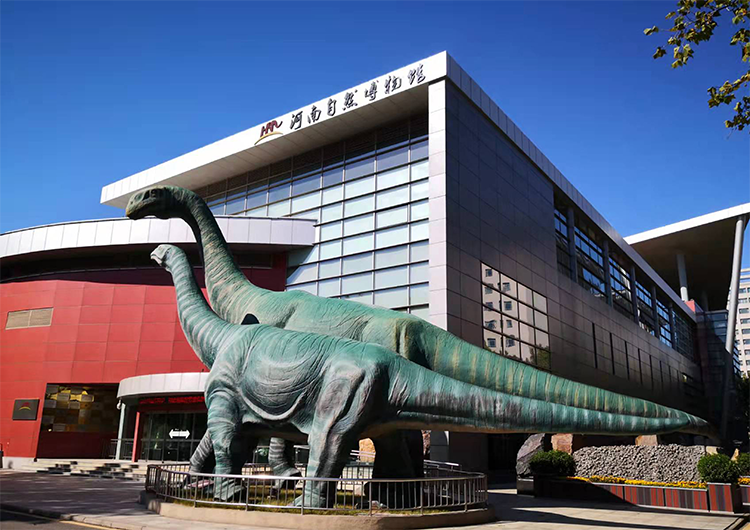Henan Natural Museum: Dinosaurs, Fossils and Mineral Specimens
Introduction:
Step into the Henan Natural Museum and walk a time corridor that unfolds 4.6 billion years of Earth history. This is not a glass-case display museum but a living theater of geology and life: dinosaur skeletons stage the drama, mineral crystals compose the poetry, and rock layers read like pages of an ancient book. Standing before Asia’s largest dinosaur embryo collection or touching ancient marine sediments, you’ll realize every step on this ground is a story told across deep time.
1. A Living Summary of Earth’s Story
As the most influential natural history museum in Central China, the Henan Natural Museum answers one of humanity’s oldest questions—where do we come from—with more than 2,000 rare specimens. Built on the deep geological legacy of the former Henan Province Geological Museum, it decodes 800 million years of the Central Plains’ geological changes. Its paleontology holdings rank among China’s top three, and the dinosaur hall is often called “a three-dimensional textbook of Asia’s Cretaceous.”
2. Architectural Language: Rock Reimagined
The building itself interprets the exhibits. The silver-gray façade uses environmentally friendly materials that mimic basalt textures, the giant glass curtain wall evokes a geological fault profile, and the central spiral ramp alludes to the tree of life. The most inspired feature is the “strata corridor”: from the entrance to the dinosaur hall the floor is inlaid with real rock layer specimens so visitors literally walk across a geological timeline from the Proterozoic to the Cenozoic.
3. Three Must-See Treasures
– World-class Dinosaur Embryo Nest Fossils: In the dinosaur hall’s center, 24 curled dinosaur embryos remain in their original burial positions—only three similarly preserved egg nests have been found worldwide. AR stations recreate the dramatic moment of hatchlings emerging from eggs.
– The Ruyang Yellow River Giant: A sauropod over 18 meters long with plant impressions on its scapula, revealing the vegetation map of the Central Plains 120 million years ago.
– Nanyang Dushan Jade “King”: One of China’s famous jades, this three-ton raw Dushan jade displays rare hibiscus-red tones and natural landscape-like veins under lighting.

4. Immersive Visit Routes
Quick Route (1.5 hours): Volcano simulation in the Earth Hall → Giant skeleton array in the Dinosaur Hall → Cambrian explosion theater in the Evolution of Life Hall.
Deep Route (4 hours): Interactive gemstone maze in the Minerals Hall → Henan geological sandbox → Early humans gallery → 4D cinema screening of “Life Epic.”
Families: Don’t miss the second-floor archaeology dig pit where children use real tools to uncover replica fossils. Photographers should aim for the “Crystal World” to capture dreamy light patterns shining through fluorite specimens.
5. Local Tips You Won’t Want to Miss
– Free paleontology expert tours are offered every Tuesday at 10:30 AM (bilingual signs, Chinese and English, indicate the meeting point).
– The northeast corner of the third floor hosts a “Microscopic World” interactive screen magnifying trilobite compound eyes to nano detail.
– The basement temporary exhibition hall frequently stages gem appraisal events; check the official website for schedules.
6. Practical Visitor Information
– Opening hours: Wednesday–Sunday 09:00–16:30 (last entry 16:00). Closed Monday and Tuesday.
– Tickets: Free but mandatory reservation via the museum’s WeChat official account “Henan Natural Museum”; foreign visitors can reserve using their passport number.
– Getting there: Metro Line 1, Huanghe Nanlu Station, Exit D; walk east on Jinshui East Road for 500 meters.
– Services: Free museum-wide Wi‑Fi; English electronic audio guides available with a 200 RMB deposit; accessible elevator at the north gate.

Conclusion:
When evening light filters through the ribs of giant dinosaurs and paints the floor with patterned shadows, you’ll understand why National Geographic called this museum “philosophically rich.” It’s more than specimen cases; it’s an epic narrative of resilience. Bring curiosity, and you’ll leave with more than photos—you’ll take home a new perspective on the planet beneath your feet.


